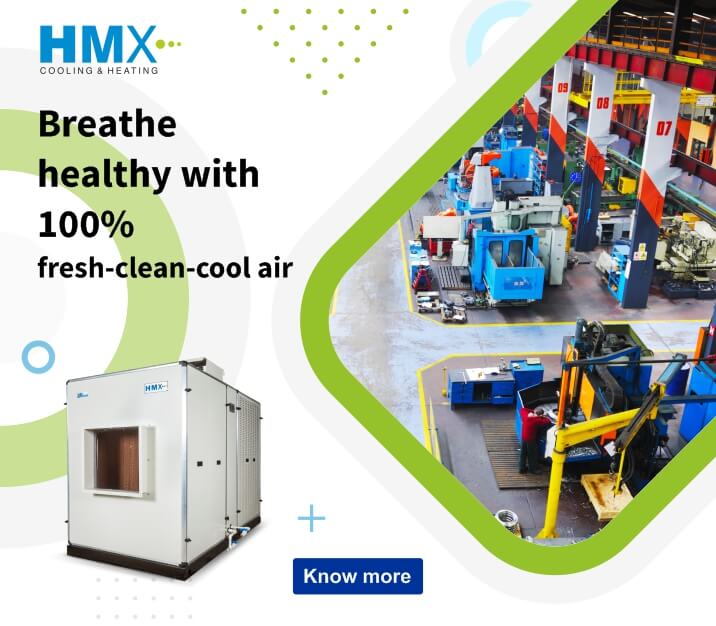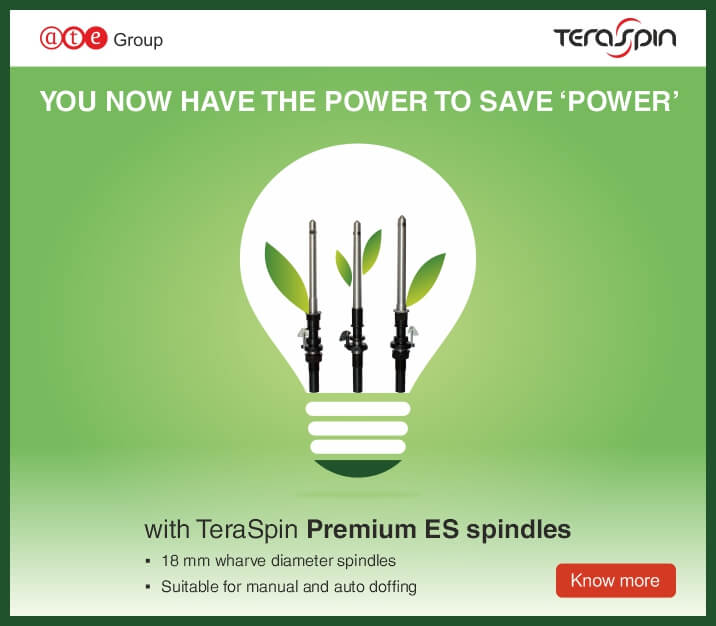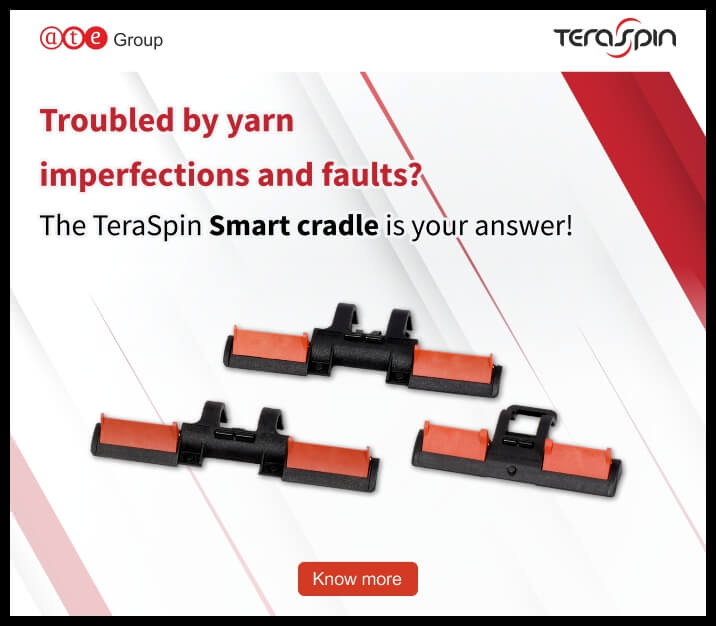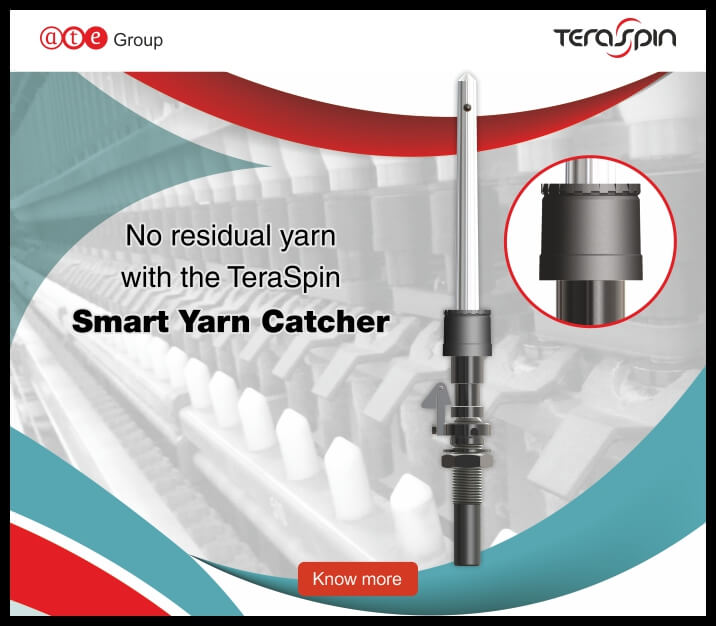FAQ
What is the HMX-Ambiator?
HMX is a trademark registered by HMX – a part of the A.T.E group. The HMX-Ambiator is a low-carbon, energy-efficient and eco-friendly space cooling solution.
What is the technology used in the HMX-Ambiator?
The HMX-Ambiator works on the principle of cooling ambient air in two stages: indirect evaporative cooling (IEC) and direct evaporative cooling (DEC). At neither stage are chlorofluorocarbons (CFCs) used.
The HMX-Ambiator uses up to 60% less energy to cool a space as compared to the energy consumed by conventional air conditioning systems to cool a similar area. The Energy and Resources Institute (TERI) certified this claim by recording the power consumed by HMX-Ambiators over a period of one year.
Since the product consumes less energy, it also emits less carbon dioxide into the air. While a conventional air conditioning unit of 1 TR capacity used for a small office will emit 1 kg of carbon dioxide per hour, a comparable HMX-Ambiator will emit only 0.4 kg of CO2 per hour.
A further benefit of the HMX-Ambiator is that it does not recirculate air, but sucks in filtered fresh air continuously from outside the building. This contributes to a healthier working environment with a minimal increase in carbon dioxide levels. Conventional air-conditioning systems only introduce up to 10% fresh air. As a result, carbon dioxide levels inside an air conditioned building can go up to more than 1,000 parts per million (ppm).
How does the HMX-Ambiator work?
HMX-Ambiator operates on the principle of two stage ‘indirect direct evaporative air conditioning’.
First stage: Sensible heat-exchanger – indirect evaporative cooling module
Ambient air is sucked through a 20 micron filter across a heat recuperator consisting of a cross-flow heat exchanger. This patented heat exchanger is the core of HMX’s technology and gives HMX products significantly higher efficiency than others. In this stage, sensible cooling (the term used in the HVAC industry to mean reducing the temperature of air) is achieved without adding moisture.
Second stage: Adiabatic heat-exchanger – evaporative cooling module
The already cooled air passes through an evaporative cooling module, where limited quantities of water help cool the air further.
HMX-Ambiator is a 100% fresh air system. HMX-Ambiator requires water and power. It does not require steam, waste heat or any other energy source.
What are the various applications of the HMX-Ambiator?
- Comfort conditioning of offices, commercial complexes such as malls, auditoriums, marriage halls, multiplexes, hotels and hospitals, educational institutions, etc.
- Industrial ventilation and cooling
- Pre-cooling of air for DG sets, gas turbines
- Spot cooling in high heat areas such as foundries, furnaces, etc.
- Pre-coolers for hybrid applications – combining with regular air conditioners
How is the HMX-Ambiator ‘eco-friendly’?
Regular air conditioning systems use ozone depleting CFCs. The HMX-Ambiator does not use any CFCs as it does not use any compressor for cooling air. Furthermore, the Ambiator saves a lot of power compared to alternative cooling solutions.
How does the HMX-Ambiator maintain Indoor Air Quality (IAQ)?
Regular air conditioners recycle 90-95% air of/from the conditioned space – a good installation typically has about 5 to 10% fresh air injected into the room. Thus, at best, in an air conditioned room, the occupants get only about 5 to 10% fresh air. In several cases of air conditioner installations, the occupants suffer from lack of adequate fresh air.
In the case of HMX-Ambiator, 100% of the air pumped into the room is fresh. HMX-Ambiator continuously sucks in fresh air, filters the air of any impurities and cools this air. This cool air is distributed into the room. The continuous induction of fresh, cool and clean air ensures that the problem of IAQ is eliminated.
How is the HMX-Ambiator different from desert coolers or single stage evaporative coolers or air washers?
An air washer and the Ambiator both work on the principle of evaporative air cooling. An air washer brings down the DBT (Dry Bulb Temperature) of ambient air to a temperature, which is very close to the WBT (Wet Bulb Temperature). This is done with the addition of a lot of moisture in the ambient air through direct evaporative cooling.
On the other hand, the Ambiator brings down the ambient air DBT to a temperature much lower than the WBT through the combination of indirect and direct evaporative cooling. This is obtained by adding only half the amount of moisture that is added in an air washer. This results in higher degree of cooling with much lower moisture levels.
The HMX-Ambiator is an IDEC (indirect-direct evaporative air conditioning) machine which is quite different from single stage evaporative coolers and air washers.
How much power saving can an HMX-Ambiator give as compared to conventional AC systems?
The HMX-Ambiator can provide superior cooling and ventilation and at the same time consume up to 60% less energy than a conventional mechanical vapour compression AC.
Can HMX-Ambiator be used to maintain comfortable indoor air conditions under any weather ambient conditions and for all geographic locations?
The wet bulb temperature has the greatest significance on the applicability of the HMX-Ambiator. A high wet bulb temperature would result in high machine outlet temperatures. However, enhanced air movement can provide thermal comfort to a larger extent. Evaporative cooling systems can be successfully applied in hot and dry areas. Hybrid systems can provide thermal comfort in humid ambient conditions.
Is there any recommended maximum temperature for the use of the HMX-Ambiator?
There is no maximum ambient temperature limit for application of the HMX-Ambiator, except that the wet bulb temperature has the greatest significance on the applicability of the HMX-Ambiator. A high wet bulb temperature would result in high machine outlet temperatures, which may not allow maintaining space temperatures within the acceptable temperatures for thermal comfort.
Does HMX-Ambiator increase humidity?
The HMX-Ambiator works on the principle of IDEC (Indirect Direct Evaporative Cooling). As the water is added to the supply air in the second stage, the RH of supply air increases compared to the ambient air RH. But remember that the temperature has also dropped. It is the combination of temperature and humidity that creates human comfort. Evaporative air conditioners are used so widely around the world because they actually create comfortable conditions. Furthermore, comfort is also improved by increasing air velocity in hot conditions and evaporative air conditioners do create sufficient air movement, adding to comfort.
What is the maximum humidity the HMX-Ambiator can work with?
For good results, the outdoor humidity should not exceed about 60% at the hottest part of the day. And don’t forget that the humidity is lowest when the temperature is highest during a normal 24-hour cycle and humidity may be a lot lower than you think when the temperature is at an extreme point. That is when you want maximum cooling and that is when your evaporative air conditioner will function best.
The wet bulb temperature has the greatest significance on the applicability of HMX-Ambiator. During the periods of high humidity conditions, the second stage adiabatic heat exchanger need not be taken online. Instead, the situation can be handled by providing a cooling coil of DX/CW type to dehumidify and cool the supply air.
Will humidity due to use of the HMX-Ambiator, affect computers and other electronic and electrical devices?
No. It is the condensation of moisture which affects the electronic devices in the room, and the Ambiator cools with non-condensing humidity. In environments that are suitable to install the HMX-Ambiator, the room RH levels are generally below 70%. Since computers or electronic devices emit thermal radiation and their surface temperatures are above the dew point, condensation of moisture cannot occur.
Does the humidity / moisture levels increase due to the use of the HMX-Ambiator have any detrimental effect on materials such as wood, gypsum board, POP, etc.?
In the environments that are suitable to install HMX-Ambiator, the room RH levels are generally below 70%. As the surface temperatures of interior components such as gypsum board, POP, etc., are at temperatures which are above the dew point temperature, the use of HMX-Ambiator does not affect these materials.
Does the performance of the HMX-Ambiator deteriorate during the monsoon season?
Monsoon affects the performance of HMX-Ambiator. A higher wet bulb temperature means higher moisture in air – and hence it reduces the cooling performance of the Ambiator. On the other hand, however, the dry bulb temperature also tends to be lower during the monsoon season; hence the cooling load is lower and the air velocity provided by the Ambiator often provides sufficient comfort.
Can we use HMX-Ambiator for controlled humidification of the space?
No. The HMX-Ambiator is not a machine to be used for controlling or maintaining room humidity conditions.
How can HMX-Ambiator be useful in coastal areas?
In coastal areas, the HMX-Ambiator can be effectively used for in-spot cooling applications, ventilation of factory spaces and large halls, etc. However, comfort conditioning of offices will be difficult.
How does evaporative air cooling affect human health? Is there any direct impact of high humidity on human health?
We all go to beaches, don’t we? The RH is over 90% there. With the monsoon in Mumbai, India, the humidity is over 80% over a prolonged period; does anything happen to the residents of this city? The key issue is having enough fresh air.
Evaporative air conditioners are excellent for health. They provide basic moisture that the human body needs; they remove unhealthy pollution from the indoor environment; they supply 100% fresh, filtered air into your building that is never re-circulated; they remove static electricity; they have proved to be successful in reducing the effects of illnesses such as asthma. In fact, evaporative air conditioning is much healthier than conventional air conditioning.
Is evaporative cooling good for asthmatic people?
Evaporative air conditioners are excellent for health. They provide basic moisture that the human body needs; they remove unhealthy pollution from the indoor environment; they supply 100% fresh, filtered air into your building that is never re-circulated; they remove static electricity; they have proved to be successful in reducing the effects of illnesses such as asthma. In fact, evaporative air conditioning is much healthier than conventional air conditioning.
Has the HMX-Ambiator been independently evaluated both for performance as well as for power savings? What are the findings?
In a demonstration case study supported by the Indo-German Energy Efficiency project – a joint initiative of the Governments of India and Germany and implemented by The Tata Energy Research Institute (now called The Energy Research Institute), Bangalore, the HMX-Ambiator was approved as an ‘Energy Saving Product’ for comfort air conditioning applications.
The case study results are based on close monitoring of the installation at site over a period of time and hence the saving potential and other parameters are those that are actually realised. As per the published case study DCS 001, the benefits of using HMX-Ambiator in comparison to a conventional air conditioning system are:
- Lower capital cost
- Very low power consumption
- 100% fresh air on a continuous basis
COMPARISON OF CONVENTIONAL AIR CONDITIONING SYSTEM WITH HMX-Ambiator
- Conventional air conditioning
- HMX-Ambiator-based air conditioning
- Can provide 20-24ºC temp. and 30-60% RH
- Can provide less than 26ºC dry bulb temperature for 96 % of time in a year and RH in the range of 60-70%, in many locations
- Power requirement: 1.2 kW/TR
- Power requirement only 5 to 0.6 kW/TR, demand saving also possible
- Typically 10 % fresh air
- 100% fresh cool air
- Sick building syndrome envisaged
- No problems of sick building syndrome
- Poor indoor air quality
- Excellent indoor air quality
- CFCs causing ozone depletion
- Eco-friendly as no CFCs involved
What kind of online or offline water cleaning system is provided in the HMX-Ambiator?
There is no offline water cleaning system in the HMX-Ambiator. However, an online water treatment system is provided for disinfection of water.
Is it feasible to retrofit HMX-Ambiator in existing HVAC installations?
Yes, but difficult. It needs detailed evaluation as the HMX-Ambiator is a 100% fresh air system, the air quantities required to handle the room – sensible heat loads can be 30 to 50% higher than that used in a conventional air conditioning system. Hence, the duct sizes are larger. Case to case evaluation is needed.
Can the HMX-Ambiator be used for enclosed spaces?
When the HMX-Ambiator system is used for enclosed spaces, a return exhaust air system along with properly designed ducting is required to realise the full benefits of HMX-Ambiator usage.
How does the capacity of the HMX-Ambiator compare with conventional air conditioners? How does the capacity of the HMX-Ambiator compare with the TR required for an air conditioning system for a given space?
In case of conventional AC, the capacity is rated in terms of ’TR’, which indicates its heat removal capacity (1TR = 12000 BTU/hour) and the dehumidified air quantity of the AHU is decided based on ADP and required room temperature.
Whereas, in the case of HMX-Ambiator, its capacity is rated in terms of ‘CFM’ alone. The capacity of the HMX-Ambiator is decided considering the room heat load, ambient and room conditions, field experience of similar operating installations such as CFM per square feet of floor area or number of air changes needed to provide desired comfort conditions. Thus, selection of HMX-Ambiator capacity needs elaborate analysis.
Is water treatment needed?
Treated water, limiting hardness and TDS to less than 400 PPM is required to avoid scale formation in the heat exchangers. The scale formation and fouling of this equipment can deteriorate their thermal efficiency and may result in unsatisfactory temperatures in conditioned spaces. As explained earlier, scaling promotes bacterial growth. Besides, scaling increases maintenance frequency and increases maintenance costs. Hence, to realise the full benefits of HMX-Ambiator, it is necessary to use treated water, in case untreated water has high TDS or hardness.
Is the control system comparable with conventional AC? Can it control temperature and RH as an AC does?
Only a precision AC controls both temp and RH. A precision AC therefore, heats, cools, humidifies and dehumidifies whereas regular ACs control only temperature – and do not control RH.
In HMX-Ambiator, we do not dehumidify air. However, we can plot a spread of temperature and control within the range. RH would be default function as in the case of AC.
What is the standard delivery period for supply of the HMX-Ambiator?
Depending upon the size of an HMX-Ambiator, the delivery period of an HMX-Ambiator varies from 4 to 8 weeks from the date of receipt of clear P.O. with advance payment.
What type of civil work/foundation is needed for installation of the HMX-Ambiator?
No special foundation and foundation bolts are needed for installation of the HMX-Ambiator. However, a concrete pedestal of about 150 mm high is recommended.
What is the standard installation and commissioning period?
Installation and commissioning period depends upon the size and scope of the order. Typically 10 to 15 days are required.
What is the life of the HMX-Ambiator? What are the parts to be maintained and what are the maintenance requirements?
With the implementation of recommended maintenance practices, the life of many parts of HMX-Ambiator can be 15 years. However, parts such as heat exchangers may require replacement as and when their fouled condition reaches a stage where it’s no longer possible to clean them further.
Is AMC offered with HMX-Ambiator? What is the expected cost of AMC?
Annual maintenance contracts (AMC) can be offered. Typical maintenance costs of HMX-Ambiator would be like any other comparable capital equipment in the industry.
How does HMX-Ambiator compare with conventional AC, w.r.t. capital cost? Cost per square foot for installation?
It is difficult to provide a figure for capital cost of HMX-Ambiator system on a per square foot basis without a specific analysis. The success of evaporative air conditioning system largely depends upon the proper design of the room air exhaust system. In closed spaces, there is a need to provide exhaust air ducting, which can add to capital cost. Whereas in large halls, with a good number of windows/ ventilation openings, there is no need for exhaust air ducting.
Besides, for certain geographical humid locations, with the need for having controlled room temperatures throughout the year, may necessitate introduction of cooling coils with a DX/CW system. This again adds to the capital cost.
Thus, depending on the applications, the capital cost of the HMX-Ambiator system may be lower or higher than a conventional AC system.
What happens to humidity of air after evaporative cooling?
The cooled air from the HMX-Ambiator travels through the distribution duct network and picks up duct heat gain due to frictional losses and room sensible heat of the conditioned spaces, resulting in reduced Relative Humidity (RH)
What are the maintenance needs of HMX-Ambiator?
The following parts of HMX-Ambiator need routine maintenance:
1) Suction strainers of pumps
2) Heat exchangers
3) Air pre-filters
4) Water tank
What are the critical spares required for 1 year and 3 years' operations?
Critical spares for operation are belts, filters and a spare pump.
How often is it required to drain water out from the HMX-Ambiator?
The HMX-Ambiator has an automatic water drain arrangement. If the system is not operating for 24 hours, it is programmed to automatically drain water out. This avoids algae formation, prevents mosquito breeding and a foul smell on restart.
What chemicals need to be added to sump to avoid bacterial growth?
No chemical is recommended to be added to the circulating water in HMX-Ambiator.
What is the frequency of cleaning the sump water?
Generally, once in 15 days is adequate








